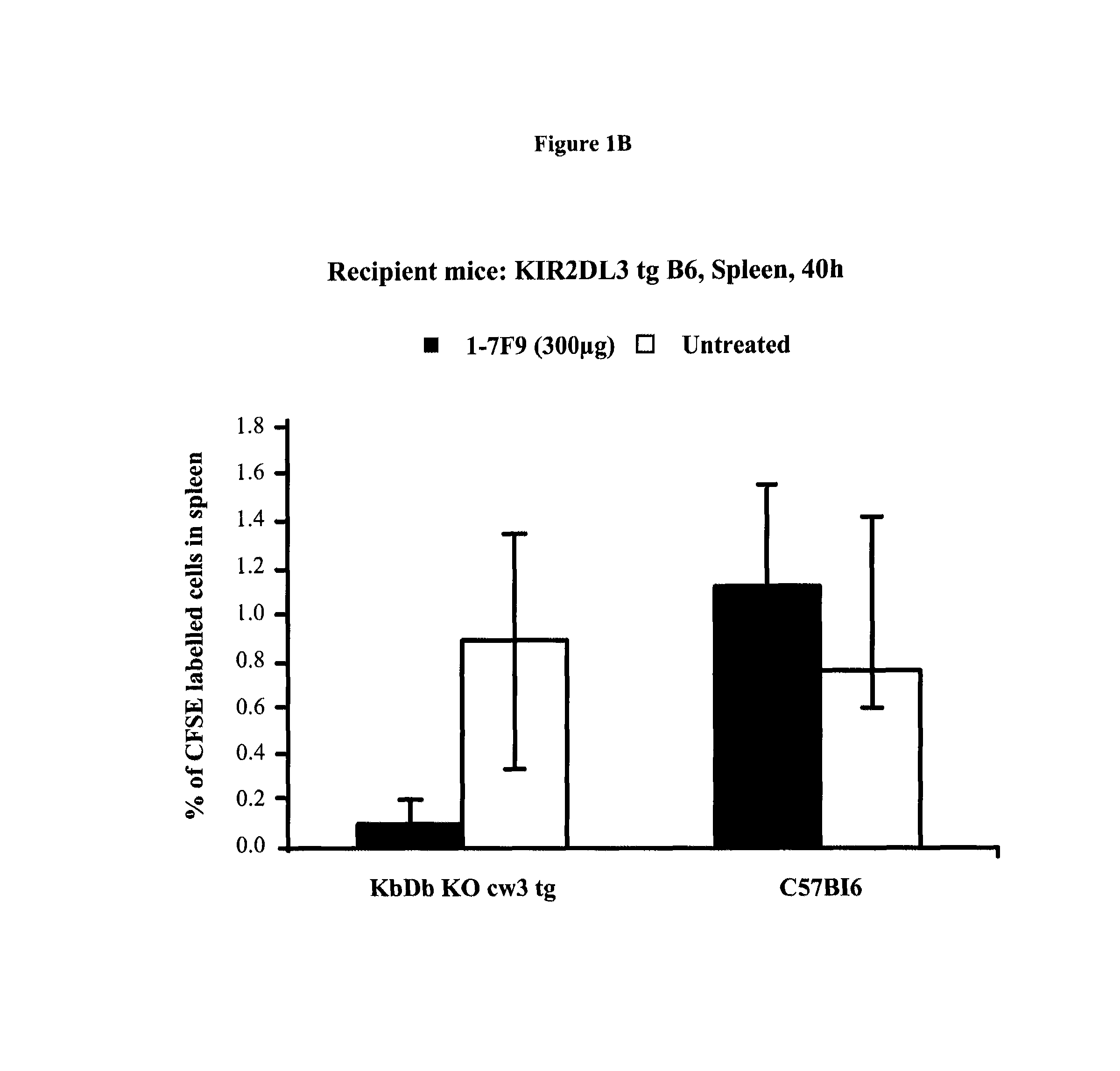Anti-KIR antibodies for the treatment of inflammatory and autoimmune disorders
a technology of inflammatory and autoimmune disorders, applied in the direction of antibody medical ingredients, immunological disorders, drug compositions, etc., can solve the problems of immune system that cannot distinguish between self and non-self, cell ineffectiveness in performing vital immune system functions, response that destroys normal body tissues, etc., and achieves the effect of potentiating nk cell cytotoxicity
- Summary
- Abstract
- Description
- Claims
- Application Information
AI Technical Summary
Benefits of technology
Problems solved by technology
Method used
Image
Examples
example 1
Pharmacokinetics in Patients
[0649]Plasma concentrations of anti-KIR (1-7F9) are determined by ELISA as briefly described below.
[0650]The plates are coated with KIR2DL3 coating solution (100 μl / well) and incubated overnight at about +4° C. The plates are then washed 3 times with wash buffer using an automated plate washer (400 μl / well). Blocking buffer is added (200 μl per well) and plates are incubated for approximately 2 hours on a plate shaker at room temperature. After this, the plates are once again washed 3 times with wash buffer (400 μl / well).
[0651]Standards, quality controls and samples are added to the plates (100 μl / well) before incubation for approximately 2 hours on the plate shaker at room temperature. Before adding mouse anti-human IgG4:peroxidase working solution (100 μl / well) the plates are washed another 3 times (as above). The plates are then again incubated for approximately 2 hours on a plate shaker at room temperature, after which they are washed once again.
[0652...
example 2
KIR Occupancy Assay
[0653]Receptor occupancy is evaluated on human whole blood samples by four-color fluorescence analysis. Briefly, free and bound KIR2D receptor levels are assessed on T and NK lymphocytes in EDTA anti-coagulated peripheral blood. Free site assay will assess unbound KIR2D by staining with PE-conjugated 1-7F9, which binds to the KIR2D molecule. Bound site assay will assess KIR2D receptors occupied by 1-7F9 by staining with a PE-conjugated mouse anti-human IgG4 monoclonal antibody that recognizes the 1-7F9 bound to the KIR2D receptors. The Free and Bound Assays will allow for assessment of both percentage positive staining as well as the fluorescence intensity [MESF] for 1-7F9-PE or anti-hIgG4-PE. The following combinations of conjugated antibodies are used in the following two assays:
[0654]Free Site Assay: CD3 / 1-7F9 / CD45 / CD56
[0655]Bound Assay: CD3 / hIgG4 / CD45 / CD56.
[0656]Samples are analyzed on a Becton Dickinson FACScalibur using the Becton Dickinson Cellquest softwar...
example 3
Clinical Safety and Auto-Reactivity
[0657]A single dose escalation trial was conducted in elderly acute myeloid leukemia (AML) patients (>60 years), who are in first complete remission following induction and consolidation chemotherapy, and not eligible for bone-marrow transplantation. A standard 3+3 design is applied, and a total of 7 dose levels were explored: Doses range from 0.0003 mg / kg to 3 mg / kg. Following dosing, the patients were monitored for safety, PK and KIR occupancy until KIR occupancy was no longer detectable.
[0658]An extension trial was also conducted. AML patients who had completed the dose-escalation trial and who were still in complete remission could participate in the extension trial, in which the patients were dosed up to 6 times on a monthly basis. The patients are dosed with the same dose as they received in the previous trial.
Patients, Materials and Methods
[0659]In both trials, elderly AML patients (>60 years of age) in their first complete remission (CR) an...
PUM
| Property | Measurement | Unit |
|---|---|---|
| dosing frequency | aaaaa | aaaaa |
Abstract
Description
Claims
Application Information
 Login to View More
Login to View More - R&D
- Intellectual Property
- Life Sciences
- Materials
- Tech Scout
- Unparalleled Data Quality
- Higher Quality Content
- 60% Fewer Hallucinations
Browse by: Latest US Patents, China's latest patents, Technical Efficacy Thesaurus, Application Domain, Technology Topic, Popular Technical Reports.
© 2025 PatSnap. All rights reserved.Legal|Privacy policy|Modern Slavery Act Transparency Statement|Sitemap|About US| Contact US: help@patsnap.com



